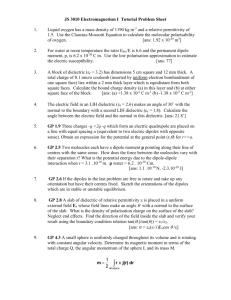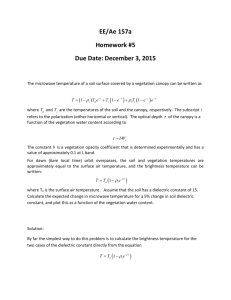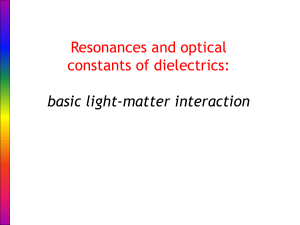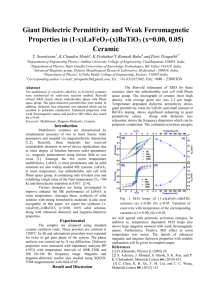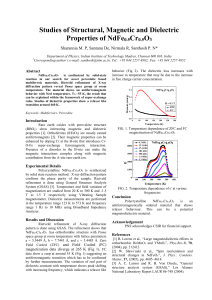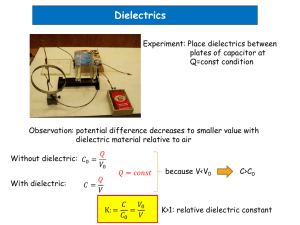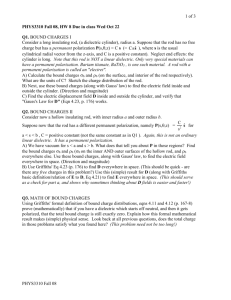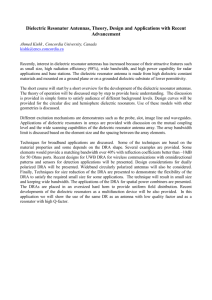HW10
advertisement
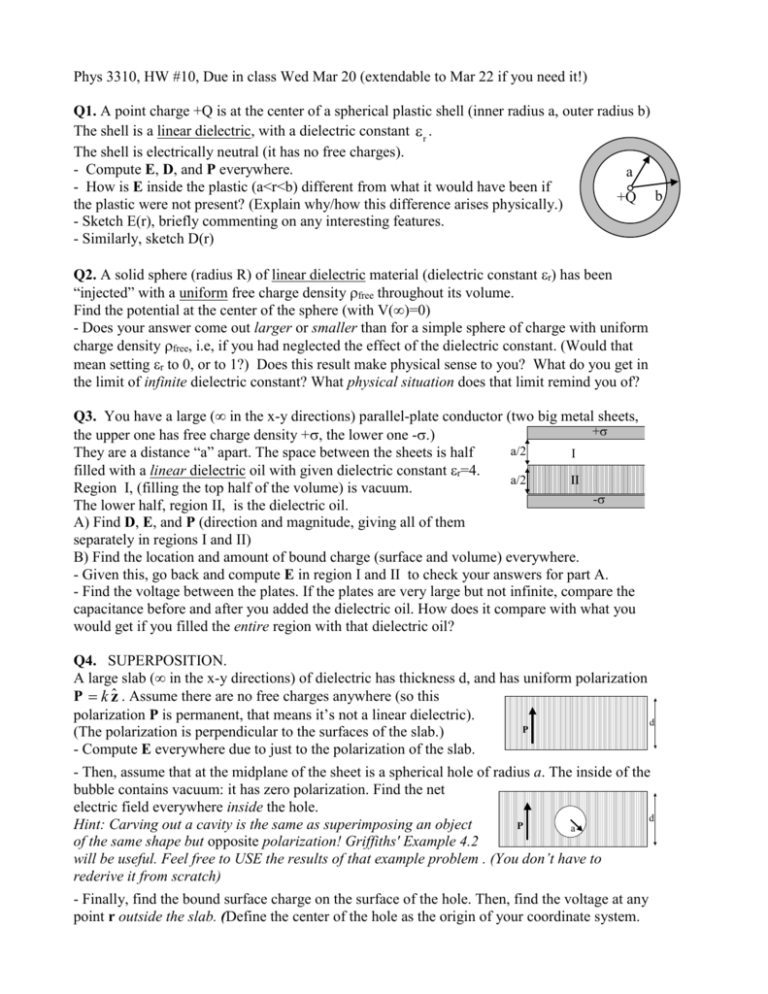
Phys 3310, HW #10, Due in class Wed Mar 20 (extendable to Mar 22 if you need it!) Q1. A point charge +Q is at the center of a spherical plastic shell (inner radius a, outer radius b) The shell is a linear dielectric, with a dielectric constant e r . The shell is electrically neutral (it has no free charges). - Compute E, D, and P everywhere. a - How is E inside the plastic (a<r<b) different from what it would have been if +Q b the plastic were not present? (Explain why/how this difference arises physically.) - Sketch E(r), briefly commenting on any interesting features. - Similarly, sketch D(r) Q2. A solid sphere (radius R) of linear dielectric material (dielectric constant r) has been “injected” with a uniform free charge density free throughout its volume. Find the potential at the center of the sphere (with V(∞)=0) - Does your answer come out larger or smaller than for a simple sphere of charge with uniform charge densityfree, i.e, if you had neglected the effect of the dielectric constant. (Would that mean settingr to 0, or to 1?) Does this result make physical sense to you? What do you get in the limit of infinite dielectric constant? What physical situation does that limit remind you of? Q3. You have a large (∞ in the x-y directions) parallel-plate conductor (two big metal sheets, +s the upper one has free charge density +, the lower one -) a/2 They are a distance “a” apart. The space between the sheets is half I filled with a linear dielectric oil with given dielectric constant r=4. a/2 II Region I, (filling the top half of the volume) is vacuum. -s The lower half, region II, is the dielectric oil. A) Find D, E, and P (direction and magnitude, giving all of them separately in regions I and II) B) Find the location and amount of bound charge (surface and volume) everywhere. - Given this, go back and compute E in region I and II to check your answers for part A. - Find the voltage between the plates. If the plates are very large but not infinite, compare the capacitance before and after you added the dielectric oil. How does it compare with what you would get if you filled the entire region with that dielectric oil? Q4. SUPERPOSITION. A large slab (∞ in the x-y directions) of dielectric has thickness d, and has uniform polarization P = k zˆ . Assume there are no free charges anywhere (so this polarization P is permanent, that means it’s not a linear dielectric). d P (The polarization is perpendicular to the surfaces of the slab.) - Compute E everywhere due to just to the polarization of the slab. - Then, assume that at the midplane of the sheet is a spherical hole of radius a. The inside of the bubble contains vacuum: it has zero polarization. Find the net electric field everywhere inside the hole. d Hint: Carving out a cavity is the same as superimposing an object P a of the same shape but opposite polarization! Griffiths' Example 4.2 will be useful. Feel free to USE the results of that example problem . (You don’t have to rederive it from scratch) - Finally, find the bound surface charge on the surface of the hole. Then, find the voltage at any point r outside the slab. (Define the center of the hole as the origin of your coordinate system. Phys 3310, HW #10, Due in class Wed Mar 20 (extendable to Mar 22 if you need it!) You should assume there are still no free charges anywhere, and set V(∞)=0.) Q5. FIELD PATTERNS FROM BOUND CHARGES Consider a solid dielectric rod (radius a), with a “frozen in” polarization. Let's change the polarization from what we had last week – here, assume it is uniform and parallel to the z-axis, i.e. P = k zˆ . This time, let's also keep the rod finite, and consider realistic "end effects". i) Sketch the electric field lines, inside and outside, in two different limits: First, when the cylinder is very LONG compared to its diameter, and second, when it is very SHORT compared to its diameter. Explain in words and formulas your reasoning. ii) In both of the above two limiting cases, sketch (and explain in words) P everywhere in space, and also D everywhere (inside and outside the rods) iii) In both of the above limits, explain/show how Griffiths' "boundary condition" Eq 4.26 and 4.28 work out nicely right at the center of the top end of the rod. Also (briefly, very qualitatively, just in terms of signs/directions of these fields) explain how boundary conditions 4.27 and 4.29 makes sense/agree with your sketches in part ii. (ONLY consider the outer edge of the middle of the cylinder (i.e. z=0, if the rod runs from z=-L to +L) Such an object is a "bar electret", an electrical analogue of a permanent bar magnet. Do you see why, from your sketches? This is unusual, most materials can’t maintain a permanent electric polarization in the absence of an external field. If you did have one, it would attract ions from the air which would negate the interesting fields you found above. Q6. MODELING A SOLID DIELECTRIC In class, we considered a large plastic (dielectric) slab inside an external capacitor, as shown. wire We modeled it as built of atoms with charges +q and –q, attached to -sfree each other by a spring (given spring constant k). Suppose there are n of these atoms per unit volume in the slab. (Assume the slab and Eext P? D? Etot? capacitor are ∞ in the x-y directions.) Given this model, review our in-class Tutorial to remind yourself +sfree how to write the bound surface charge, and thus polarization, in terms of q, n, and the amount the little springs have all stretched: z. The “given constants” here are n, q, and k (the spring constant), A) Figure out a formula for the dielectric constant of this material in terms of these given constants. Note that Eext is given, but I claim that the dielectric constant better not depend on it. Still, it may be needed in “intermediate steps”. Similarly, z is not a “given constant” - it depends on Eext! But I suggest you just give it the name z and feel free to write intermediate expressions in terms of it. Partway through, you will find you can eliminate it too! I have written extensive hints to guide you through this problem – check the website. B) It’s always a good idea to check using units, and limiting cases. Do so! For “limiting cases”, I’m thinking about “super stiff” springs, and “super floppy” springs. What physical situation does the “super stiff” spring correspond to? Does your formula give you that? How about for a “super weak” spring? Does your limit for Etot make sense? One more check: in a linear dielectric can │Eind│ever be larger than │Eext│? What does your formula in part A have to say about this? Phys 3310, HW #10, Due in class Wed Mar 20 (extendable to Mar 22 if you need it!) EXTRA CREDIT: (tricky but worth thinking about, you can learn a lot from this one!) Consider two concentric conducting spherical shells of radii a and b as shown in the figure. The space between them is filled with a liquid having a dielectric constant r. A total charge of “+Q” is placed in the inner conducting shell and “-Q” in the outer shell. a) Find the magnitude and direction of the fields E, D, P everywhere; namely for r > b, a < r < b, and r < a. b) Determine expressions for the free surface charge on each conducting shell everywhere (namely, on the dielectric side, and the air side). c) Determine expressions for the bound charge at r = a and r = b. d) Determine the potential everywhere. b a If you want some help with this challenging problem, see our website – I have posted a “Tutorial” that walks you through many of the steps required in more detail! Be careful to satisfy the boundary conditions everywhere, including the boundary between the dielectric and the air (consider it vacuum) in between the spherical shells. If you think a bit about satisfying the boundary conditions you will notice that the solution for the “E” field is very simple, and makes a good starting point for the problem! (Once you know E somewhere, D is very simple to find, it's just E, with =ro = a given constant!) It would not be safe to assume that the charge "Q" on the inner metal sphere will distribute itself uniformly - after all, there will be (opposite) bound charges forming next to it in the bottom half, but not on the top half. So, where do you expect to see more charge congregate, the top half or the bottom half of that sphere?

